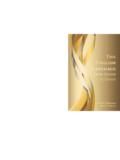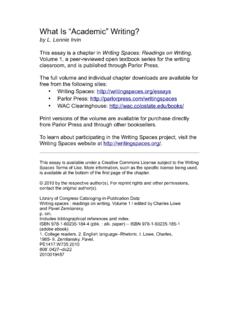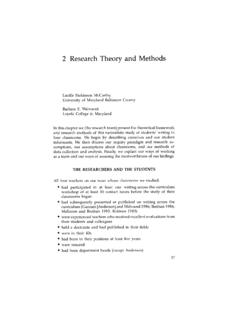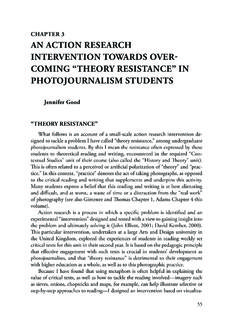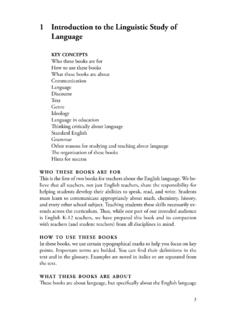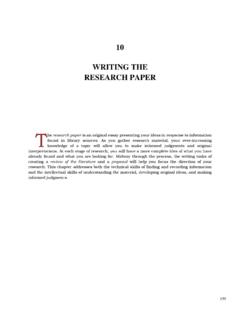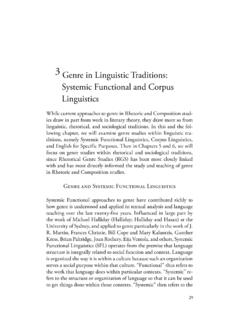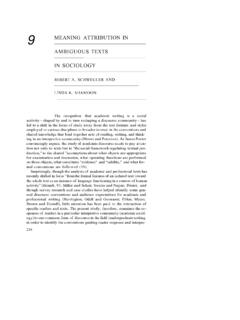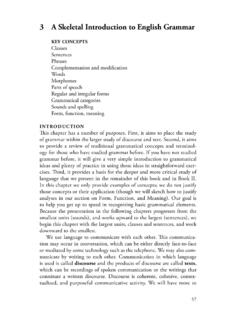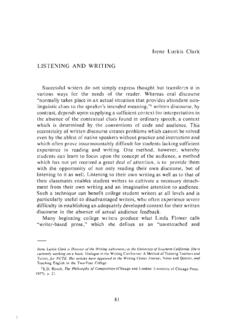Transcription of The Sixth Paragraph: A Re-Vision of the Essay
1 The Sixth Paragraph: A Re-Vision of the Essay by Paul Lynch This Essay is a chapter in Writing Spaces: Readings on Writing, Volume 2, a peer-reviewed open textbook series for the writing classroom. Download the full volume and individual chapters from: Writing Spaces: Parlor Press: WAC Clearinghouse: Print versions of the volume are available for purchase directly from Parlor Press and through other booksellers. This Essay is available under a Creative Commons License subject to the Writing Spaces'. Terms of Use. More information, such as the specific license being used, is available at the bottom of the first page of the chapter. 2011 by the respective author(s). For reprint rights and other permissions, contact the original author(s). Library of Congress Cataloging-in-Publication Data Writing spaces : readings on writing. Volume 1 / edited by Charles Lowe and Pavel Zemliansky. p. cm. Includes bibliographical references and index.
2 ISBN 978-1-60235-184-4 (pbk. : alk. paper) -- ISBN 978-1-60235-185-1 (adobe ebook). 1. College readers. 2. English language--Rhetoric. I. Lowe, Charles, 1965- II. Zemliansky, Pavel. 2010. 808'.0427--dc22. 2010019487. The Sixth Paragraph: A Re-Vision of the Essay Paul Lynch Part the First Recently, I taught a class called Introduction to the Essay . * It was not a first year writing class, which most students are required to take, but a sophomore elective. For a long time, nobody signed up for the course. I didn't understand why. I was prepared to teach some great stuff: essays about love, sex, mashed potatoes, turtles, getting lost, get- ting drunk, getting migraine headaches, noise, things people hate, things people love, and deer antlers. (I'll explain this last one later.). When students finally did sign up, it was at the last minute, when all the other required English classes had already filled. Eventually, after I. got to know my students and they got to know me, I felt comfortable enough to ask them why they had been reluctant to take the class.
3 To be honest, one student said, it was the title. It just didn't sound that interesting. I asked them what they thought they'd be writing in the course. School essays, they said. The kind we've been writing all our lives.. Looking back, I'm surprised that I hadn't seen it coming. When I. was a middle school teacher, I decided to cover the bare walls of my * This work is licensed under the Creative Commons Attribution- Noncommercial-ShareAlike United States License and is subject to the Writing Spaces' Terms of Use. To view a copy of this license, visit http://. or send a letter to Creative Commons, 171 Second Street, Suite 300, San Francisco, California, 94105, USA. To view the Writing Spaces' Terms of Use, visit http://writingspaces. org/terms-of-use. 286. The Sixth Paragraph: A Re-Vision of the Essay 287. classroom with some posters. I went down to the supply closet, and I. found one that immediately grabbed my attention: it was called The Cheeseburger Essay .
4 Maybe I grabbed it because I was hungry. Any- way, the poster pictured a triple-cheeseburger I must have been re- ally hungry and each part of the sandwich was stamped with part of an Essay . I'll bet that most of my Intro to the Essay students could have diagrammed the poster even without seeing it. The top bun was the introduction. The cheese was the thesis. Each of the three patties represented a reason that supported the thesis. And the bottom bun was the conclusion. So let's say I were asking my middle school stu- dents to write a cheeseburger Essay about whether they should get homework every night: Students have always gotten a lot of homework. Teachers think it is important because it helps students, but the stu- dents do not like it because it is more work. Students should not get homework every night for three reasons. First, they have many extracurricular activities. Second, they should spend time with their families at night.
5 Third, they should rest so they can be ready for school the next day. Students have many extracurricular activities. They do sports, music lessons, and art classes .. I'm sure you could write the rest of this Essay in your sleep. (Per- haps you already have.) You know the rules, just like my students did. When I asked them what an Essay was, they said the following. First, it has five paragraphs . Why five? I asked. Because you need one for your introduction, one for each of your three reasons, and one for your conclusion. What goes in the introduction? The thesis and the reasons. What else? Don't use the pronoun I. Why not? Because you're sup- posed to be making arguments based on the support, and the support should prove the point. If you use I, then it sounds like you're say- ing these things. Don't include your personal opinion because your opinion doesn't matter. Essays should speak for themselves. Don't use you either, they told me.
6 It's too informal. And don't I mean, do not use contractions. Whenever I teach college writing classes, I always ask how many students have been taught the five paragraph form. Almost every hand goes up every time. Why does everyone learn it? One, it's easy to re- member. Two, it's easy to perform. If you're writing an SAT or AP. 288 Paul Lynch exam, the five paragraph Essay gives you a blueprint that you can re- produce quickly. To be honest, it's also easy to grade. A teacher can recognize the parts very quickly. Is there an intro? Check. A thesis? Check. Reason #1? Check, and so on. For a high school teacher with 125 students, being able to read and grade quickly is crucial. So there are some good reasons to teach the five paragraph Essay . Many of your college writing classes, by the way, will be capped at twenty students;. the idea is to make grading papers a little easier and giving feedback a little more worthwhile. Unfortunately, you might also have an adjunct professor who's teaching four or five sections, which means they might have as many students as your high school teachers.
7 They may be in- clined to ask for these kinds of formal structures if only so they can keep their heads above water. In any case, you may have noticed that I've just listed exactly three reasons why the five paragraph Essay gets taught: Students have al- ways been taught the five paragraph Essay . Teachers teach it for three reasons. First, it is easy to remember. Second, it's easy to perform. Third, it's easy to grade.. Once again, you can probably see how this very Essay on the Essay going to shape up. And the bad habit of slipping into the five paragraph structure also reminds me of my bad conscience. I hung that cheeseburger poster in my classroom and taught my students to follow its advice so that they would do well on our state-mandated standardized tests. ( Who is your hero? Give three reasons why. ) Such advice isn't terrible, and I don't mean to pick on middle and secondary school teachers, not only because I was a middle and secondary school teacher, but also because the vast majority of my college students have been very well prepared by the time they get to my class.
8 (Notice that I just offered two reasons for my opinion, and I used an I. I even used the passive voice. What will he do next?!?). Third of all damn .. I still cannot get out of the habit of offering three reasons the good old five paragrapher does feature the basics. Academic writing should make an argument; arguments should have reasons; reasons should be based on evidence. But as you can see, the form tends to straitjacket writing: it fits everyone, but once you're in it, you can't really move. English teachers often complain that people think of us as the grammar police. (Introduce yourself as an English teacher, and you're sure to hear something like, Oops, I better watch my grammar. ). This gets old, but I suppose we have no one but ourselves to blame. The Sixth Paragraph: A Re-Vision of the Essay 289. We spend a lot of our time marking grammatical errors and writing things like AWK (as in awkward), CLARIFY, SPECIFY, etc.
9 Again, I feel guilty about this I've written these kinds of comments more times than I can remember. But they're not very helpful, are they? I. might as well scribble Write better! in the margins. Kind of like yell- ing Kick it! at a soccer game. A student might ask, If I knew how to CLARIFY, SPECIFY, and avoid AWK-ing, then don't you think I. would have done it already? It seems as if we want student writing to be like clean glass: we should see right through it to what you're telling us. The writing should be as clear as crystal, easily understood, with no effort on the reader's part required. The writing should also be brief and concise. No unnecessary words. Sentences should be like assembly lines, with not a move wasted. No hemming or hawing. Our previous five paragraph example exemplifies this plain style: Students have al- ways gotten a lot of homework. Teachers think it is important because it gives students practice, but students do not like it because it is more work.
10 Sure, it's clear, brief, and sincere, but it's also really dreary and boring. Would you write or talk like this in any other part of your life? Imagine a five paragraph love letter. It would start like this: Since the dawn of time, men have written love-notes to women. I find you attractive and would like to accompany you to the local Cineplex for three reasons. First, we share many of the same interests and hobbies. Second, we like the same kinds of movies. Third, your beauty causes me to per- spire excessively. This is clear and brief, and it's even got three reasons, but it's prob- ably not going to win anyone's heart. (By the way, that was the Sixth paragraph of the present Essay . I'm just saying.). What if you wrote an introduction like this? Others form Man; I give an account of Man and sketch a picture of a particular one of them who is very badly formed and whom I would truly make very different from what he is if I had to fashion him afresh.
